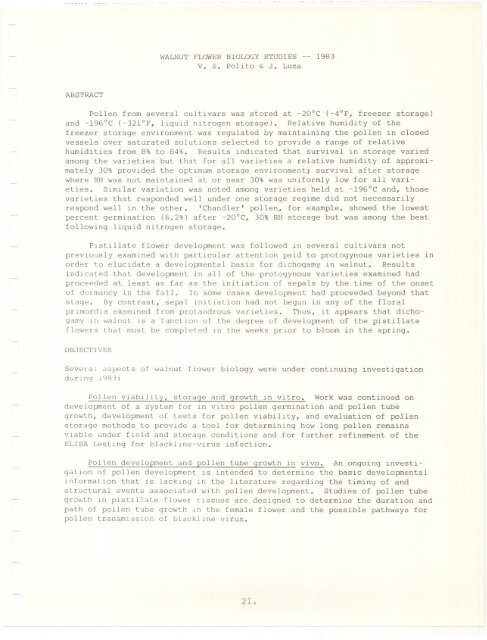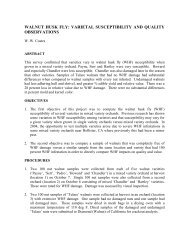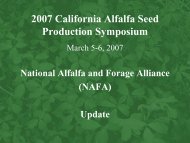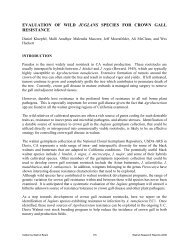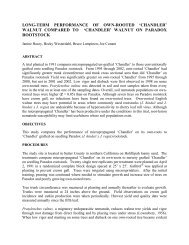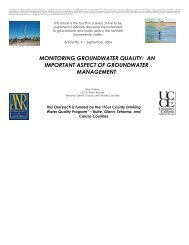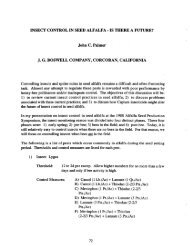WALNUT FLOWER BIOLOGY STUDIES - Walnut Research Reports
WALNUT FLOWER BIOLOGY STUDIES - Walnut Research Reports
WALNUT FLOWER BIOLOGY STUDIES - Walnut Research Reports
You also want an ePaper? Increase the reach of your titles
YUMPU automatically turns print PDFs into web optimized ePapers that Google loves.
<strong>WALNUT</strong> <strong>FLOWER</strong> <strong>BIOLOGY</strong> <strong>STUDIES</strong> -- 1983<br />
V. S. Polito & J. Luza<br />
ABSTRACT<br />
Pollen from several cultivars was stored at -20°C (-4°F, freezer storage)<br />
and -196°C (-321°F, liquid nitrogen storage). Relative humidity of the<br />
freezer storage environment was regulated by maintaining the pollen in closed<br />
vessels over saturated solutions selected to provide a range of relative<br />
humidities from 8% to 84%. Results indicated that survival in storage varied<br />
among the varieties but that for all varieties a relative humidity of approximately<br />
30% provided the optimum storage environment; survival after storage<br />
where RH was not maintained at or near 30% was uniformly low for all varieties.<br />
Similar variation was noted among varieties held at -196°C and, those<br />
varieties that responded well under one storage regime did not necessarily<br />
respond well in the other. 'Chandler' pollen, for example, showed the lowest<br />
percent germination (6.2%) after -20°C, 30% RH storage but was among the best<br />
following liquid nitrogen storage.<br />
Pistillate flower development was followed in several cultivars not<br />
previously examined with particular attention paid to protogynous varieties in<br />
order to elucidate a developmental basis for dichogamy in walnut. Results<br />
indicated that development in all of the protogynous varieties examined had<br />
proceeded at least as far as the initiation of sepals by the time of the onset<br />
of dormancy in the fall. In some cases development had proceeded beyond that<br />
stage. By contrast, sepal initiation had not begun in any of the floral<br />
primordia examined from protandrous varieties. Thus, it appears that dichogamy<br />
l.nwalnut is a function of the degree of development of the pistillate<br />
flowers that must be completed in the weeks prior to bloom in the spring.<br />
OBJECTIVES<br />
Several dspects of walnut flower biology were under continuing investigation<br />
during 1983:<br />
Pollen viability, storage and growth in vitro. Work was continued on<br />
development of a system for in vitro pollen germination and pollen tube<br />
growth, development of tests for pollen viability, and evaluation of pollen<br />
storage methods to provide a tool for determining how long pollen remains<br />
viable under field and storage conditions and for further refinement of the<br />
ELISA testing for blackline-virus infection.<br />
Pollen development and pollen tube growth in vivo. An ongoing investigation<br />
of pollen development is intended to determine the basic developmental<br />
information that is lacking in the literature regarding the timing of and<br />
structural events associated with pollen development. Studies of pollen tube<br />
growth in pistillate flower tissues are designed to determine the duration and<br />
path of pollen tube growth in the female flower and the possible pathways for<br />
pollen transmission of blackline virus.<br />
21.
Pistillate flower development. Two aspects of pistillate flower development<br />
are under investigation: floral organogenesis during the months prior to<br />
bloom and details of ovule development as it proceeds during the weeks immediately<br />
prior to bloom. One objective is to extend previous studies of the<br />
timing of key events in flower development to additional varieties, particularly<br />
recent releases and protogynous varieties, and to elucidate the developmental<br />
basis for protogyny. Another is to understand, in detail, critical<br />
cellular events associated with determinants of flower quality and fruit set.<br />
Pistillate flower receptivity and ovule quality. Histological and cytochemical<br />
parameters affecting pistillate flower receptivity and ovule strength<br />
are being examined. Our objectives are to describe events associated with<br />
fertilization and normal set and how these may differ in ovules which undergo<br />
post-pollination abortion.<br />
PROCEDURES<br />
Pollen storage and pollen tube growth in vitro. Pollen was collected<br />
from representative varIeties several days prior to anther dehiscence and at<br />
the time the first staminate flowers of the catkin had begun to shed pollen.<br />
Pollen was tested for Initial germination percentage on artificial medium at<br />
the time of collectIon.<br />
Pollen was stored at -20°C over saturated salt solutions selected to<br />
provide a range of relatIve humidity (RH) environments for storage. Salts<br />
used and approxl.mateRH at -20°C for each were: LiCl.2H20 (18%), MeCOOK'1.5H20<br />
(28%), MgC12.6H20 (33%), CaBr2.6H20 (30%), NaI.2H20 (48%), NaBr2.2H20 (70%)<br />
dnd NH Cl (84%). NaOH.H20 was also used to provide a low RH (ca. 8%) as well.<br />
Samplp~ were removed and assayed for viabilIty after 3 and 8 months. Tests of<br />
liquid nItrogen storage of pollen were also done. This year a long-term<br />
liquid TIltrr.:>genfacility was used. Pollen was cooled to liquid nitrogen<br />
temperatures (-196°C) at a rate of IOC per minute and held at that temperature<br />
for 8 months. In each case a final sample will be assayed for survival in<br />
storage dfter one year.<br />
Pollen development. Catkins were collected beginning 4 to 6 weeks before<br />
staminate bloom and at intervals thereafter. These samples were fixed and<br />
embedded in plastic resins for high resolution light and electron microscopy.<br />
Material was sectioned and stained for specific chemical constituents (protein,<br />
total carbohydrates specific components of the pollen cell wall, storage<br />
lipids) as well as for general structural features of pollen development.<br />
Pistillate flower development. Shoots of selected protandrous varieties<br />
('Ashley', 'Chandler', 'Howard') and the five protogynous varieties available<br />
at Davis ('Chico', 'Amigo', 'Sharkey', 'XXX Mayette', 'Meylan') were collected<br />
at two-week intervals during the period of pistillate flower development.<br />
Terminal and lateral (where appropriate) buds were dissected from the shoots,<br />
prepared for light and electron microscopy, and examined for development of<br />
the floral organs. Samples of pistillate flowers were collected daily for the<br />
two weeks prIor to bloom and ovules and stigmatlc tissue were prepared for<br />
light and electron microscopy.<br />
22.
Pollen tube growth, fertilization and fruit set. Pistillate flowers of<br />
'Chico' were pollinated with 'Serr' pollen and collected at two day intervals<br />
for the next two weeks. Flowers were fixed and embedded in paraffin for<br />
microscopic analysis of pollen tube path and details of ov~le development and<br />
fertilization.<br />
RESULTS AND CONCLUSIONS<br />
Pollen storage and pollen tube growth in vitro. Controlling the relative<br />
humidity of the storage environment greatly enhanced the storage life of<br />
pollen from all varieties. Optimum RH for storage was in the range of 30%<br />
which provided significant improvement over freezing without regulation of RH.<br />
While varieties with high retention of viability under uncontrolled storage<br />
did improve greatly, the effect was most dramatic in varieties that failed to<br />
germinate at all after a short time in storage. 'Chandler' and 'Tehama' were<br />
two such varieties going from ° to 6.2% in the case of 'Chandler' and 23.6% in<br />
the case of 'Tehama'. We tentatively conclude (pending one-year testing) that<br />
storage at -20°C (= -4°F) should be possible if the relative humidity of the<br />
storage environment is maintained at approximately 30% by using a saturated<br />
solution of MeCOOK.l.5H20 (potassium acetate), CaBr2.6H20 or MgCI2.6H20. Even<br />
under these conditions viability in storage will vary among cultivars and, in<br />
the case of some cultivars (eg. 'Chandler'), will be insufficient for effective<br />
use in a field situation. However, where the objective of pollen storage<br />
is to have material for hand pollinations, as in the walnut breeding program,<br />
it seems likely that the method described should be useful. We further conclude<br />
that under storage without controlled RH the likelihood of having a high<br />
percentage of viable pollen is low.<br />
Our results for liquid nitrogen storage also indicated variability among<br />
thp varjpties tested. Interestingly, 'Chandler' pollen, which had the poorest<br />
response to storage at -20°C, was extremely responsive to storage at -196°C.<br />
Pistlilate flower development. This year's investigation has extended<br />
previous work to several new varieties. As noted in previous studies, the<br />
time of initiation of a floral meristem varies among varieties and there is no<br />
clear correlation with earliness of bloom or protogyny. protogyny does appear<br />
to have its basis in developmental events occurring during the season prior to<br />
bloom. In the case of each of the protogynous varieties significantly greater<br />
development had occurred prior to the onset of dormancy in the fall. Typically,<br />
development in the protogynous varieties had proceeded to the stage of<br />
sepal initiation, and in many cases, subsequent stages were attained by that<br />
time. By contrast, in none of the protandrous varieties examined this year,<br />
or in previous studies, had floral primordia developed beyond the initiation<br />
of the involucral ring and the emergence of bracts and bracteoles. Thus, when<br />
development resumes in the spring the pistillate flowers of protogynous varieties<br />
have completed all early organogenesis; all that remains is the completion<br />
of pistil formation. Protandrous varieties must initiate and complete<br />
the development of the calyx and early stages of pistil before they are at the<br />
same stage proLogynous variet lea had attained by mid-November. The time<br />
required to complete this develoIEent would account for the delay of pistillate<br />
bloom to some time after pollen shedding.<br />
23.
A second factor examined was the extent of differences between terminally<br />
and laterally borne flowers. Little difference was noted in the timing of<br />
development between the terminal and the first few lateral buds. However,<br />
proceeding down the shoot to more basal lateral buds in strong lateral bearers<br />
such as 'Chandler' and 'Howard' we noted that development is delayed relative<br />
to the terminal and more apical lateral buds. The effect of this phenomenon<br />
is that in these lateral bearing varieties there is substantially more variation<br />
in stages of pistillate flower development at any given time during the<br />
summer growing season.<br />
Pollen tube growth and fertilization. Since the work of German plant<br />
morphologists at the turn of the century, the pollen tube growth path in ~<br />
regia has been considered to be chalazogamous. That is, rather than pollen<br />
tubes entering the ovule through the micropyle as is typical for nearly all<br />
flowering plants, the pollen tubes are supposed to grow around to the basal<br />
(chalazal) end of the ovule, through the vascular tissue supplying the ovule<br />
and enter the ovule through the side opposite the micropyle. This view of<br />
pollen tube growth is so well entrenched in the literature on floral biology<br />
that ~ regia is typically listed in textbooks as the prime example of chalazogamous<br />
fertilization. We, as well as others interested in the transmission<br />
of blackline virus in walnut, have assumed that this is the case and have<br />
designed our analyses based on this assumption. Over the past two years we<br />
have come to believe that this is not the case after all. We believe that we<br />
have identified the artifact that led earlier workers to suppose that the<br />
species is chalazogamous and have reasonably good evidence that the usual mode<br />
of fertilization, entry of the pollen tube through the micropyle, is the case<br />
in walnut.<br />
24.<br />
-


